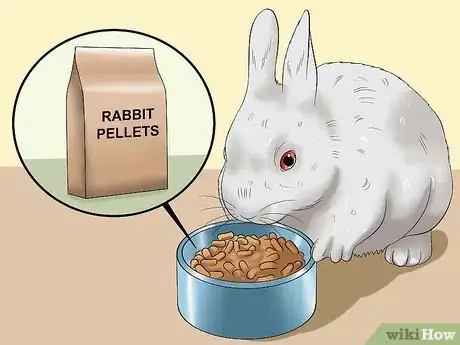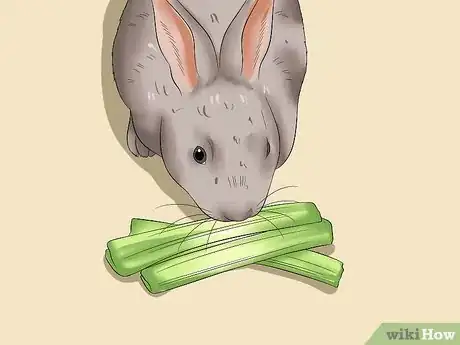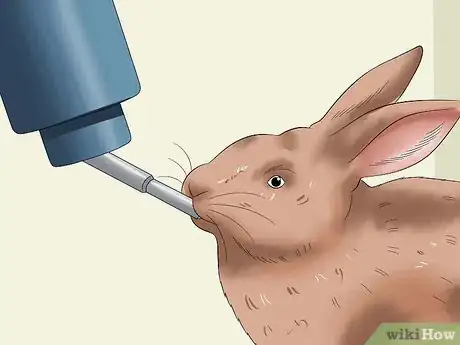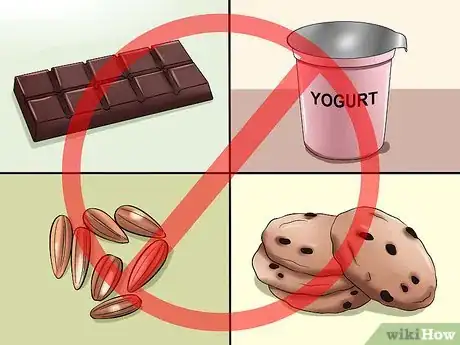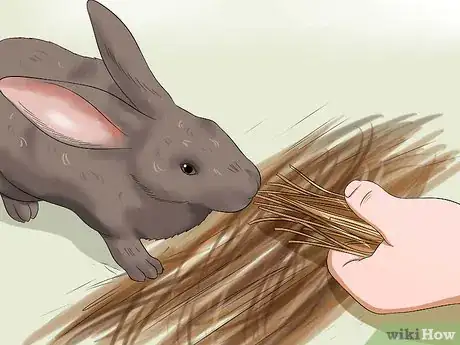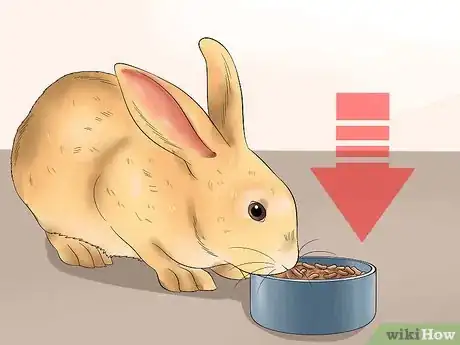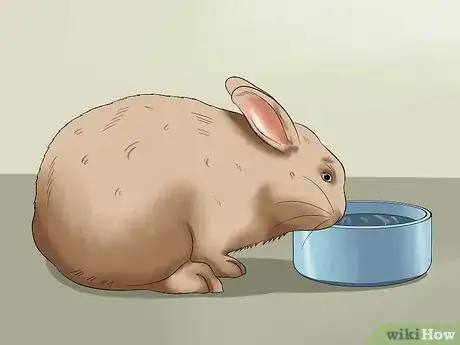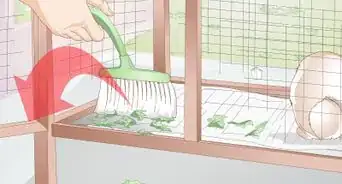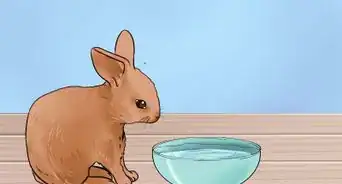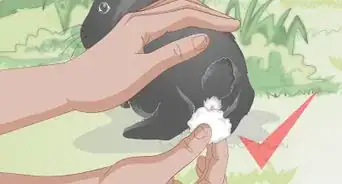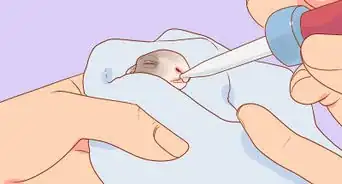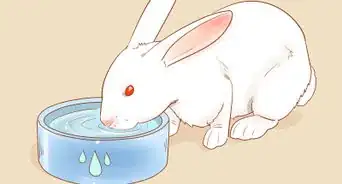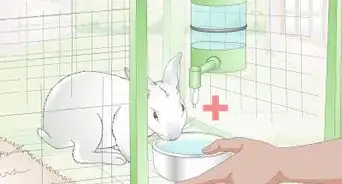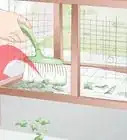This article was co-authored by Pippa Elliott, MRCVS. Dr. Elliott, BVMS, MRCVS is a veterinarian with over 30 years of experience in veterinary surgery and companion animal practice. She graduated from the University of Glasgow in 1987 with a degree in veterinary medicine and surgery. She has worked at the same animal clinic in her hometown for over 20 years.
wikiHow marks an article as reader-approved once it receives enough positive feedback. This article has 17 testimonials from our readers, earning it our reader-approved status.
This article has been viewed 404,122 times.
Rabbits are wonderful animals to keep as pets. Feeding your pet rabbit a healthy and balanced diet is essential to keeping him happy and healthy as he grows older. Rabbits have a very sensitive digestive system—nutritional imbalances can quickly lead to serious intestinal problems that can have fatal consequences.[1] Knowing how to feed your rabbit properly will help you keep him in optimal health throughout his life.
Steps
Learning What to Feed Your Rabbit
-
1Provide your rabbit with hay. Hay is the most important part of your rabbit’s diet.[2] It has many benefits. For example, hay has fiber, which helps move waste through your rabbit’s intestines and prevent intestinal stasis (‘gut stasis’).[3] Hay also gives your rabbit something to chew on, which helps him keep his teeth filed down.[4]
- In addition, hay can keep your rabbit entertained, since he can sift through it and move it around his enclosure.[5]
- Grass hay (e.g., timothy, oat) is higher in fiber than alfalfa or clover hays, and is thus the ideal type of hay to feed your rabbit.[6] Alfalfa and clover hays are high in protein and calcium, which can lead to kidney and bladder problems in older rabbits.[7]
- Good quality hay is green and fragrant, and is free of mold and dust.[8]
- Consider buying your hay from your local feed store. Compared with the hay at a pet store, hay at a feed store will likely be fresher and contain more of the nutrients your rabbit needs.[9]
-
2Include pellets in your rabbit’s diet, in moderation. Pellets should only make up a small amount of your rabbit's diet. They are high calorie and low fiber which leads to obesity and overgrown teeth. Give extruded pellets only (each kibble looks the same) rather than muesli type diets (as these encourage selective eating of the tastier, low calcium components). Each day, give your rabbit about one ounce per pound they weigh. If your rabbit is addicted to pellets and won't eat hay, then make a gradual change over by cutting back on the pellets and making sure they have access to sweet, green hay.
- Pellets should be approximately 18% to 20% crude fiber, 14% to 16% protein, and 1% each of fat and calcium.[10] [11]
- The pellets you feed your rabbit should be timothy-based, rather than alfalfa-based.[12]
- Avoid pellets sold through feed stores or markets that are not in sealed packaging. Exposure to the air degrades the vitamins and makes for reduced nutrition. Ideally, buy the smallest sealed bag of food possible since a large bag once opened will start to degrade.
Advertisement -
3Feed your rabbit fresh vegetables. Fresh vegetables keep your rabbit’s intestines well hydrated,[13] which helps with overall digestion. There are many vegetables that you can feed your rabbit, including celery, collard greens, green peppers, and radish tops.[14] Vegetables with high levels of vitamin A, such as broccoli, carrots, and mustard greens, are especially important to feed your rabbit.[15]
- There is often a concern that feeding vegetables gives rabbits diarrhea. This would mainly occur if you introduce multiple vegetable types to your rabbit’s diet simultaneously, rather than one at a time.
- Starchy vegetables, such as carrots, should be fed in moderation.[16]
- Fresh fruits are also good additions to your rabbit’s diet, but should be fed only as treats,[17] due to their high sugar content.
-
4Give your rabbit fresh, clean water. A constant supply of fresh, clean water is essential to keeping your rabbit’s intestines well hydrated. Without enough water, intestinal contents can become very dry and get stuck. This can lead to gut stasis, which could be life threatening if not treated immediately.[18]
-
5Learn what not to feed your rabbit. There are several foods that you should never feed your rabbit, including chocolate, pasta, and yogurt.[21] Seeds, cookies, and crackers, and high-fiber cereals are also off-limits to your rabbit.[22]
- These foods can cause a dangerous buildup of "bad" bacteria in your rabbit’s gut, leading to a serious condition called enterotoxemia.[23] They can also cause fatty liver disease and contribute to obesity.[24]
- Avoid feeding corn to your rabbit. Because rabbits cannot digest corn hulls, feeding your rabbit corn could lead to life-threatening intestinal blockage.[25]
Learning How to Feed Your Rabbit
-
1Feed your rabbit unlimited grass hay. With hay being such an important component of your rabbit’s diet, it makes sense that he should have plenty of it on a daily basis. Rabbits of all ages, from baby to adult, should be fed an unlimited amount of grass hay each day.[26]
- Young rabbits that have been weaned from their mothers and are able to eat on their own should begin eating hay as soon as possible.[27] [28]
- Consider placing the hay at one end of your rabbit’s litter box. Your rabbit will likely enjoy being able to sit in a comfortable box and munch on hay at the same time. In addition, putting the hay in the litter box can help keep his cage clean.[29]
-
2Limit the amount of pellets in your rabbit’s diet. With pellets, your rabbit can have too much of a good thing. Limit your rabbit’s daily pellet intake to one ounce per one pound of body weight.[30] [31]
- A high amount of pellets in your rabbit’s diet can lead to obesity.[32]
- Because pellets don’t contain much fiber, a diet that is high in pellets would cause your rabbit’s feces to become very mushy and get stuck in the hair around your rabbit’s anus (known as "poopy butt syndrome").[33]
- Your rabbit may begin to prefer the pellets to the hay, which could lead to nutritional imbalances and digestive issues.[34]
- Baby rabbits can have an unlimited quantity of pellets—the high protein and calcium content will help their growth. If you have a baby rabbit, begin to decrease his pellet intake gradually at 3-4 months or age until he is down to the recommended adult amount.[35]
-
3Feed your rabbit an adequate amount of fresh vegetables. Your rabbit should eat two to four cups of fresh vegetables per five pounds of body weight.[36] The vegetables must be fresh — spoiled vegetables, and even those that are slightly less than fresh, can upset your rabbit’s sensitive digestive system.[37]
- Serve the vegetables wet — the moistness will provide much-needed hydration to your rabbit’s intestines.[38]
- Divide the total amount of daily vegetables in half. Feed one-half in the morning and the other half in the evening.[39]
- Feed your rabbit three types of vegetables per day, with at least one vegetable being high in vitamin A.[40] The website rabbit.org/what-to-feed-your-rabbit/ has a list of vegetables that are high in vitamin A.
- Introduce new vegetables to your rabbit’s diet one at a time to prevent digestive upset. Remove any vegetables from his diet that cause soft stool or diarrhea.[41]
- If you have a baby rabbit, feed him vegetables in very small quantities.[42] Consult with your veterinarian if you are unsure what amount of vegetables to feed your baby rabbit.
- Rinse carrot tops and radish tops thoroughly before feeding them to your rabbit.[43]
-
4Include fresh fruits in your rabbit’s diet as occasional treats. Rabbits have a sweet tooth,[44] and would probably love to eat a lot of fruit. However, because of the high sugar content, fruits should be fed only as treats. Per day, your rabbit should receive no more than one to two tablespoons of fruit per five pounds of body weight.[45]
- Examples of fruit you can feed your rabbit include mangoes, bananas, papayas, and cherries.[46]
- Rinse the fruit thoroughly before feeding it to your rabbit.
-
5Provide your rabbit with water in a sturdy bowl and/or bottle. A heavy ceramic bowl is ideal for supplying water to your rabbit.[47] Porcelain bowls are also suitable, as long as they are lead-free.[48]
- Change out your rabbit’s water at least once a day. You should also clean the water bowl with soap and hot water on daily basis.[49]
- Rabbits can also drink water from a sipper bottle. However, rabbits tend to prefer water bowls over sipper bottles. If your rabbit likes the sipper bottle, regularly check it to ensure the end is not leaky or blocked.[50]
Expert Q&A
Did you know you can get expert answers for this article?
Unlock expert answers by supporting wikiHow
-
QuestionHow long do rabbits live as a pet?
 Pippa Elliott, MRCVSDr. Elliott, BVMS, MRCVS is a veterinarian with over 30 years of experience in veterinary surgery and companion animal practice. She graduated from the University of Glasgow in 1987 with a degree in veterinary medicine and surgery. She has worked at the same animal clinic in her hometown for over 20 years.
Pippa Elliott, MRCVSDr. Elliott, BVMS, MRCVS is a veterinarian with over 30 years of experience in veterinary surgery and companion animal practice. She graduated from the University of Glasgow in 1987 with a degree in veterinary medicine and surgery. She has worked at the same animal clinic in her hometown for over 20 years.
Veterinarian
-
QuestionHow do you take care of a house rabbit?
 Pippa Elliott, MRCVSDr. Elliott, BVMS, MRCVS is a veterinarian with over 30 years of experience in veterinary surgery and companion animal practice. She graduated from the University of Glasgow in 1987 with a degree in veterinary medicine and surgery. She has worked at the same animal clinic in her hometown for over 20 years.
Pippa Elliott, MRCVSDr. Elliott, BVMS, MRCVS is a veterinarian with over 30 years of experience in veterinary surgery and companion animal practice. She graduated from the University of Glasgow in 1987 with a degree in veterinary medicine and surgery. She has worked at the same animal clinic in her hometown for over 20 years.
Veterinarian
Warnings
- An improper diet can lead to many serious digestive ailments in rabbits, including cecal dysbiosis (formless, smelly fecal material), gut stasis, fatty liver disease, and enterotoxemia.[55] These conditions may be fatal if not treated early.⧼thumbs_response⧽
- A rabbit with teeth that are not filed down can suffer from digestive upset.[56] Take your rabbit to your veterinarian if you notice he has difficulty chewing or his chin seems constantly wet. Rabbits with long teeth tend to dribble excessively, which is a clue to what's going on.⧼thumbs_response⧽
- Your rabbit could be seriously ill if he has not produced feces in 12 to 24 hours. Take him to your veterinarian for immediate treatment.[57]⧼thumbs_response⧽
References
- ↑ http://www.mybunny.org/info/rabbit-diet-and-nutrition/
- ↑ http://www.bio.miami.edu/hare/diet.html
- ↑ http://www.bio.miami.edu/hare/diet.html
- ↑ http://www.mybunny.org/info/rabbit-diet-and-nutrition/
- ↑ http://www.indianahrs.org/rabbit-care/food-pellets-hay.aspx
- ↑ http://www.bio.miami.edu/hare/diet.html
- ↑ http://www.mybunny.org/info/rabbit-diet-and-nutrition/
- ↑ http://www.indianahrs.org/rabbit-care/food-pellets-hay.aspx
- ↑ http://www.mybunny.org/info/rabbit-diet-and-nutrition/
- ↑ http://www.bio.miami.edu/hare/diet.html
- ↑ http://www.mybunny.org/info/rabbit-diet-and-nutrition/
- ↑ http://www.bio.miami.edu/hare/diet.html
- ↑ http://www.bio.miami.edu/hare/diet.html
- ↑ http://rabbit.org/what-to-feed-your-rabbit/
- ↑ http://rabbit.org/what-to-feed-your-rabbit/
- ↑ http://www.bio.miami.edu/hare/diet.html
- ↑ http://www.bio.miami.edu/hare/diet.html
- ↑ http://www.bio.miami.edu/hare/diet.html
- ↑ http://www.bio.miami.edu/hare/diet.html
- ↑ http://www.mybunny.org/info/rabbit-diet-and-nutrition/
- ↑ http://rabbit.org/what-to-feed-your-rabbit/
- ↑ http://www.bio.miami.edu/hare/diet.html
- ↑ http://rabbit.org/what-to-feed-your-rabbit/
- ↑ http://www.bio.miami.edu/hare/diet.html
- ↑ http://www.bio.miami.edu/hare/diet.html
- ↑ http://www.bio.miami.edu/hare/diet.html
- ↑ http://rabbit.org/what-to-feed-your-rabbit/
- ↑ http://www.mybunny.org/info/rabbit-diet-and-nutrition/
- ↑ http://www.indianahrs.org/rabbit-care/food-pellets-hay.aspx
- ↑ http://www.mybunny.org/info/rabbit-diet-and-nutrition/
- ↑ http://www.mybunny.org/info/rabbit-diet-and-nutrition/
- ↑ http://www.bio.miami.edu/hare/diet.html
- ↑ http://www.bio.miami.edu/hare/diet.html
- ↑ http://www.bio.miami.edu/hare/diet.html
- ↑ http://www.bio.miami.edu/hare/diet.html
- ↑ http://www.mybunny.org/info/rabbit-diet-and-nutrition/
- ↑ http://www.bio.miami.edu/hare/diet.html
- ↑ http://www.bio.miami.edu/hare/diet.html
- ↑ http://www.mybunny.org/info/rabbit-diet-and-nutrition/
- ↑ http://rabbit.org/what-to-feed-your-rabbit/
- ↑ http://rabbit.org/what-to-feed-your-rabbit/
- ↑ http://www.bio.miami.edu/hare/diet.html
- ↑ http://www.mybunny.org/info/rabbit-diet-and-nutrition/
- ↑ http://rabbit.org/what-to-feed-your-rabbit/
- ↑ http://www.bio.miami.edu/hare/diet.html
- ↑ http://www.bio.miami.edu/hare/diet.html
- ↑ http://www.rspca.org.uk/adviceandwelfare/pets/rabbits/diet/planner
- ↑ http://www.bio.miami.edu/hare/diet.html
- ↑ http://www.bio.miami.edu/hare/diet.html
- ↑ http://www.rspca.org.uk/adviceandwelfare/pets/rabbits/diet/planner
- ↑ http://www.mybunny.org/info/rabbit-diet-and-nutrition/
- ↑ http://www.rspca.org.uk/adviceandwelfare/pets/rabbits/diet/planner
- ↑ http://www.mybunny.org/info/rabbit-diet-and-nutrition/
- ↑ http://www.mybunny.org/info/rabbit-diet-and-nutrition/
- ↑ http://www.bio.miami.edu/hare/diet.html
- ↑ http://www.mybunny.org/info/rabbit-diet-and-nutrition/
- ↑ http://www.mybunny.org/info/rabbit-diet-and-nutrition/
About This Article
To feed your rabbit, start by providing it with an unlimited amount of grass hay and water on a daily basis. For a more convenient option, feed your rabbit pellets. Limit the amount to 1/4 of a cup per 5 pounds of body weight per day, because rabbits that eat too many pellets can suffer from obesity. You should also feed your rabbit a portion of fresh vegetables, such as broccoli, green peppers, or celery, in the morning and another in the evening. To learn more from our Veterinary reviewer about the types of food your rabbit needs and what not to feed your rabbit, read on!

